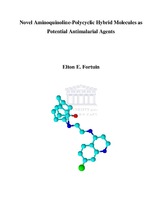| dc.description.abstract | Plasmodium falciparum malaria continues to be a worldwide health problem, especially in developing countries in Africa and is responsible for over a million fatalities per annum. Chloroquine (CQ) is low-cost, safe and was the mainstay aminoquinoline derived chemotherapeutic agent that has been used for many years against blood-stage malaria. However, today the control of malaria has been complicated by increased resistance of the malaria parasite to existing antimalarial agents such as CQ. The primary cause of resistance is mutation in a putative ATP-powered multidrug efflux pump known as the p-glycoprotein (pGP) pump, and point mutation in P. falciparum CQ resistance transporter (PfCRT) protein. These mutations are responsible for the reduced accumulation of CQ at its primary site of action, the acidic digestive food vacuole of the parasite.To overcome the challenges of CQ resistance in P. falciparum, chemosensitiser offer an attractive approach. Chemosensitisers or reversal agents are structurally diverse molecules that are known to reverse CQ resistance by inhibiting the pGP efflux pump and/or the PfCRT protein associated with CQ export from the digestive vacuole in CQ resistant parasites. Chemosensitisers include the well-studied calcium channel blocker verapamil and antihistaminic agent chlorpheniramine. These drugs have little or no inherent antimalarial activity but have shown to reverse CQ resistance in P. falciparum when co-administered with CQ. Because of the channel blocking abilities of pentacycloundecylamines (PCUs) such as NGP1-01, it is postulated that these agents may act as chemosensitisers and circumvent the resistance of the Plasmodium parasite against CQ. Therefore as a proof of concept we conducted an experiment using CQ co- administered with different concentrations of NGP1-01 to evaluate the ability of NGP1-01 to act as a chemosensitiser.Herein, we report the ability of NGP1-01, the prototype pentacycloundecylamine (PCU), to reverse CQ resistance (> 50 %) and act as a chemosensitiser. NGP1-01 alone exhibited very low intrinsic antimalarial activity against both the resistant and sensitive strain (> 2000 nM), with no toxicity to the parasite detected at 10 µM. A statistically significant (p < 0.05) dose dependent shift was seen in the CQ IC50 values at both 1 µM and 10 µM concentration of co-administeredNGP1-01 against the resistant strain. Based on this finding we set out to synthesise a series of novel agents comprising of a PCU moiety as the reversal agent (RA) conjugated to a CQ-like aminoquinoline (AM) molecule and evaluate the potential of these PCU-AM derivatives as antimalarial- and/or reversed CQ agents. As recently shown by Peyton et al., (2012), the conjugation of a CQ-like molecule with a RA such as the chemosensitiser imipramine and derivatives thereof is a viable strategy to reverse CQ resistance in multidrug-resistant P. falciparum. The novel compounds were obtained by amination and reductive amination reactions. The synthetic procedures involved the conjugation of the Cookson’s diketone with different tethered 4-aminoquinoline moieties to yield the respective carbinolamines and the subsequent imines. This was followed by a transannular cyclisation using sodium cyanoborohydride as reducing agent to yield the desired PCU-AM derivatives. The CQ-like AMderivatives were obtained using a novel microwave (MW) irradiation method. Structure elucidation was done by utilising 1H- and 13C NMR spectroscopy as well as IR absorption spectrophotometry and mass spectrometry. Five PCU-AM reversed CQ derivatives were successfully synthesised and showed significant in vitro antimalarial activity against the CQ sensitive strain (NF54). PCU-AM derivatives 1.1 – 1.4 showed antimalarial IC50 values in the ranges of 3.74 – 17.6 ng/mL and 27.6 – 253.5 ng/mL against the CQ-sensitive (NF54) and CQ-resistant strains (Dd2) of Plasmodium falciparum, respectively. Compound 1.1 presented with the highest antimalarial activity against both strains and was found to be 5 fold more active against the resistant strain than CQ. The reversed CQ approach resulted in improved resistance reversal and a significantly lower concentration PCU was required compared to NGP1-01 and CQ in combination. This may be attributed to the improved ability of compound 1.1 to actively block the pGP pump and/or the increased permeability thereof because of the lipophilic aza-PCU moiety. Compound 1.1 also showed the lowest RMI value confirming that this compound has the best potential to act as a reversed CQ agent in the series. Cytotoxicity IC50 values observed for compounds 1.1 – 1.4 were in the low micromolar concentrations (2.39 – 9.54 µM) indicating selectivity towards P. falciparum (SI = 149 – 2549) and low toxicity compared to the cytotoxic agent emetine (IC50 = 0.061 µM).These results indicate that PCU channel blockers and PCU-AM derived conjugates can be utilised as lead molecules for further optimisation and development to enhance their therapeuticpotential as reversal agents and reversed CQ compounds. | en_US |

